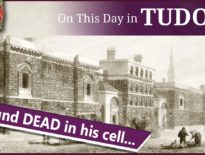On this day in Tudor history, 18th December 1575,in the reign of Queen Elizabeth I, fifty-six-year-old historian, Catholic apologist, priest and former Archdeacon of Canterbury, Nicholas Harpsfield, died in London.
Harpsfield and his brother, John, had been imprisoned since the early 1560s for refusing to swear the Oath of Supremacy, but had been released in 1574 on the grounds of ill-health.
In Mary I's reign, he had been involved in the persecutions of Protestants, and martyrologist John Foxe described him as “the sorest and of leaste compassion” of all the archdeacons involved.
Find out more about his life, career and rise, his works, and his end, in today's talk.
Note: Claire mistakenly says that he died four months after his release, she meant a year and four months! Sorry!
On this day in Tudor history, 18th December 1555, John Philpott, former Archdeacon of Winchester, was burned at the stake for heresy at Smithfield. Philpott had done a lot in his 40 years, including studying in Italy, upsetting Bishop Gardiner, and supporting fellow Protestants from his prison cell, and he died a courageous death at Smithfield in the reign of Queen Mary I. Find out more about him in last year’s video:
Transcript:
On this day in Tudor history, 18th December 1575, fifty-six-year-old historian, Catholic apologist, priest and former Archdeacon of Canterbury, Nicholas Harpsfield, died in London.
Harpsfield had been released from the Fleet prison four months earlier due to ill health. He and his brother, John, had been imprisoned since the early 1560s for refusing to swear the Oath of Supremacy. In Mary I's reign, he had been involved in the persecutions of Protestants, and martyrologist John Foxe described him as “the sorest and of leaste compassion” of all the archdeacons involved.
Harpsfield's works included “The life and death of Sr Thomas Moore, knight, sometymes Lord high Chancellor of England”, “Cranmer's Recantacyons”, “Life of Christ”, and the “Treatise on the Pretended Divorce”.
Let me give you a few more facts about this Tudor Catholic…
• Nicholas Harpsfield was born in 1519 in the parish of St Mary Magdalen, Old Fish Street, London. He was the son of mercer John Harpsfield and the nephew of doctor of canon law Nicholas Harpsfield.
• Like his uncle before him, Harpsfield studied at Winchester College and then New College, Oxford, where, in 1535, he was elected as a fellow.
• Harpsfield received his Bachelor of Law in 1543 and in 1544 he became principal of White Hall, in Oxford.
• It is thought that it was while he was at Oxford that Harpsfield met William Roper, son-in-law of Sir Thomas More, who Harpsfield viewed as a patron of his biography of More.
• In 1550, during the Protestant reign of Edward VI, Harpsfield went into exile, studying at the University of Louvain and staying in Louvain with merchant Antonio Bonvisi, who’d been close friends with Sir Thomas More. Members of the More family were also there. Harpsfield finished his biography of More in 1556/7. Harpsfield viewed More as a Catholic martyr.
• Harpsfield returned to England after the accession of the Catholic Mary I and he was made archdeacon of Canterbury in March 1554, becoming an agent of Cardinal Reginald Pole who was still abroad. Just a month later, he was granted the prebend of Harleston in St Paul’s. He was also granted several livings.
• In 1554, he attained his doctorate in law at Oxford and went on to serve as a proctor at the Court of Arches.
• Also in 1554, Harpsfield was made vicar-general of London and conducted a visitation of the city, catching about 400 Protestants, who were punished with fines and penance.
• In his own diocese of Canterbury, Harpsfield was more harsh and those Protestants who were caught were tried for heresy. Martyrologist John Foxe held him responsible for many deaths in the diocese.
• In October 1558, Harpsfield was made dean of the court of arches and dean of the peculiars. On 30th October 1558, Cardinal Pole, Archbishop of Canterbury, appointed Harpsfield to conduct a visitation of All Souls’ College, Oxford, and then, on 1st November, appointed him to the 4th prebend in Canterbury Cathedral.
• During Mary I’s reign, Harpsfield wrote his account of Archbishop Thomas Cranmer’s imprisonment, trial and execution “Cranmer’s Recantacyons”, although it was published anonymously. He also wrote his “Treatise on the Pretended Divorce”, in which he opposed Henry VIII’s great matter, the annulment of his marriage to Catherine of Aragon, and attacked Cranmer.
• On 17th November 1558, both Mary I and Cardinal Pole died, and the Protestant Elizabeth I came to the throne. In February 1559, Harpsfield was accused of inciting the people of Canterbury to sedition and stockpiling arms in the cathedral there. Harpsfield’s response was to lead a Catholic procession of the city’s citizens, which was answered by a Protestant procession. Then, in August 1559, Harpsfield refused, with other members of the Canterbury chapter, to attend the election of Matthew Parker as archbishop. Then, during a visitation of the cathedral, he and his brother John refused to subscribe to Elizabeth’s injunctions and to Book of Common Prayer. In punishment, his livings and church offices were taken off him.
• Harpsfield and his brother John also refused the oath of supremacy and so were imprisoned in the Fleet. There, Harpsfield worked on his book “Dialogi sex contra summi pontificatus, monasticae vitae, sanctorum, sacrarum imaginum oppugnatores, et pseudomartyres”, which was a rebuttal of the Magdeburg Centuries and martyrologist John Foxe’s Acts and Monuments.
• The Harpsfield brothers remained in prison until August 1574 when they were both released on the grounds of ill health. Nicholas Harpsfield died on this day in Tudor history, 18th December 1575.




Leave a Reply